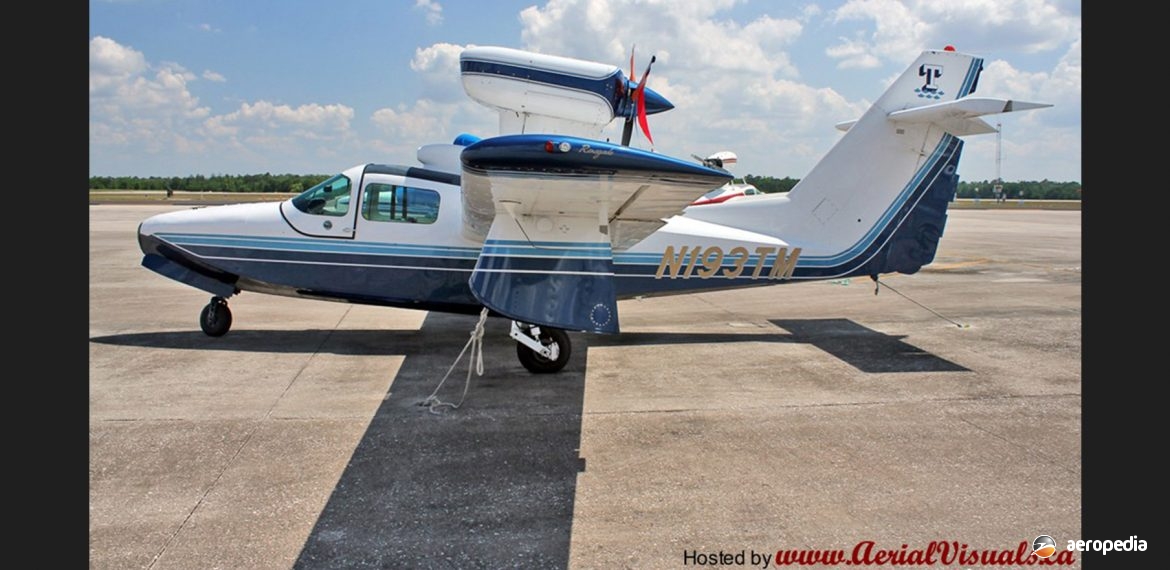Photograph:
Lake LA-270 Renegade N197TF in the United States. The LA-270 was later renamed the Sea Fury. (Author’s collection)
Country of origin:
United States of America
Description:
Five/six-seat amphibious utility aircraft
Power Plant:
One 200 kw (270 hp) Textron Lycoming TIO-540-AA1AD six-cylinder horizontally-opposed air-cooled engine
Specifications:
- Wingspan: 11.58 m (38 ft)
- Length: 8.64 m (28 ft 4 in)
- Height: 3.05 m (10 ft)
- Wing area: 15.8 m² (170 sq ft)
- Cruising speed at 1,829 m (6,000 ft): 241 km/h (150 mph)
- Cruising speed at 78% power at 6,096 m (20,000 ft): 286 km/h (178 mph)
- Service ceiling: 4,480 m (14,700 ft)
- Certified ceiling: 6,096 m (20,000 ft)
- Rate of climb: 274 m/min (900 ft/min)
- Range: 1,668 km (1,036 miles)
- Take-off roll on land: 268 m (880 ft)
- Take-off roll on water: 381 m (1,250 ft)
- Landing roll on land: 145 m (475 ft)
- Landing roll on water: 183 m (600 ft)
- Empty weight: 941 kg (2,075 lb)
- Useful load: 483 kg (1,065 lb)
- Loaded weight: 1,424 kg (3,140 lb)
History:
The LA-270 Seafury was a development of the Lake LA-250 Renegade produced by Lake Aircraft Inc of Kissimmee, Florida and was a six-seat amphibious utility aircraft developed in the United States. The Renegade was a development of the Buccaneer with a 97 cm (38 in) fuselage stretch in order to provide six seats and an increase in power to the larger Textron Lycoming IO-540-C4B5 engine. It has been produced in a number of models, including the LA-250 Renegade and the LA-270 Seawolf being a militarised variant of the Renegade with hardpoints and provision for radar in a cone at the front of the engine cowling.
Further variants have been the LA-270 Turbo Renegade with a turbocharged variant of the IO-540, and the LA-270 Seafury, these two variants being for marine environments, the Seafury being specifically aimed at operation from saltwater environments, having extra anti-corrosion measures and carrying survival gear in the event of a landing at sea.
The aircraft was a conventional mid-wing amphibian with a retractable tricycle undercarriage, the engine, like the Buccaneer, being mounted on a pylon at the rear of the cockpit. In 1988 a Turbo Renegade set an altitude class record by reaching an altitude of 7,468 m (24,500 ft). The Seawolf variant, in addition to having the radar pod, is able to carry external stores, including bombs, rocket pods, machine-gun pods or rescue equipment.
In June 2015 a company was set-up to perform seaplane services between Sydney, Newcastle and the Hunter region. Called Blue Sky Airlines, and owned by Dr Jerald Schwartz, it was announced the aircraft would perform passenger and scenic flights along the coast. Passengers were to embark at Rose Bay on Sydney Harbour and were to be conveyed to Cessnock Airport or Newcastle Harbour, the aircraft landing in Newcastle Harbour near the Crowne Plaza and Novotel Hotels. Mr Schwartz stated he was starting the service with a six-seat aircraft and was cognizant of the fact that there had previously been a 12-seat seaplane service between Sydney and Newcastle but this, he said, was not particularly successful.
It was also announced flights would operate Thursday to Monday twice a day. The aircraft in operation was to be a Renegade previously used to fly guests from Hamilton Island to Hayman Island on the north Queensland coast, and it was to be joined by an up-rated LA-270 Sea Fury. Plans were for the aircraft to take passengers to events in the Hunter Valley from Sydney, operating from Rose Bay, including the Hunter Valley Conference Centre and concerts in the vineyards, and also operating out of Cessnock. The first aircraft which entered service became VH-KIW (c/n 114) and was a Sea Fury owned and operated by Blue Sky Airways Pty Ltd of Bondi Junction, NSW, registered on 24 July 2015.
The name Sea Fury was given to the series in lieu of the Renegade name as the series was developed, and a turbocharged model was also made available, being known as the LA-270T.

